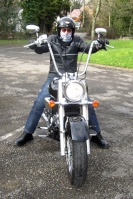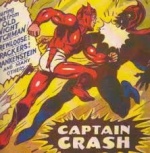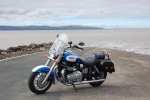
Suzuki 800 Intruder Club & Forum
A UK Site Dedicated To The Suzuki C800, VL800, VX800, M800, VZ800, VS800, C50, M50 Model Intruder / Boulevard / Marauder
|
| | | Runnng in |  |
|
+4Mr Intruder Bluesman CycleBiker admin 8 posters | | Author | Message |
|---|
admin
The Final Say!

 |  Subject: Runnng in Subject: Runnng in  Thu Feb 17, 2011 3:57 pm Thu Feb 17, 2011 3:57 pm | |
| I did not write this but whole heartedly agree, now all you got to do is read it and think about it.  Warning:
This is a very controversial topic !!
I wrote "Break-In Secrets" after successfully applying this method
to approximately 300 new engines, all without any problems whatsoever.
Links to this article now appear on hundreds of motorsports discussion forums from all over the world. The reason is that over time, large numbers of people have done a direct comparison between my method and the owner's manual method, and the news of their success is spreading rapidly.
The results are always the same... a dramatic increase in power at all RPMs. In addition, many professional mechanics have disassembled engines that have used this method, to find that the condition of the engine is much better than when the owner's manual break-in method has been used.
The thing that makes this page so controversial is that there have been many other break-in articles
written in the past which will contradict what has been written here.
Several factors make the older information on break-in obsolete.
The biggest factor is that engine manufacturers now use a much finer honing pattern in the cylinders than they once did. This in turn changes the break-in requirements, because as you're about to learn, the window of opportunity for achieving an exceptional ring seal is much smaller with
newer engines than it was with the older "rough honed" engines.
In addition, there is a lot less heat build up in the cylinders from ring friction
due to the finer honing pattern used in modern engines.
The other factors that have changed are the vastly improved metal casting and machining
technologies which are now used. This means that the "wearing in" of the new parts
involves significantly less friction and actual wear than it did in the distant past.
With that in mind ...
How To Break In Your Engine For
More Power & Less Wear !
One of the most critical parts of the engine building process is the break in !!
No matter how well an engine is assembled, it's final power output is all up to you !!
Although the examples shown here are motorcycle engines,
these principles apply to all 4 stroke engines:
Street or Race Motorcycles, Cars, Snowmobiles, Airplanes & yes ...
even Lawn Mowers !!
( regardless of brand, cooling type, or number of cylinders. )
These same break in techniques apply to both steel cylinders and Nikasil, as well as the ceramic
composite cylinders that Yamaha uses in it's motorcycles and snowmobiles.
What's The Best Way To Break-In A New Engine ??
The Short Answer: Run it Hard !
Why ??
Nowadays, the piston ring seal is really what the break in process is all about. Contrary to popular belief, piston rings don't seal the combustion pressure by spring tension. Ring tension is necessary only to "scrape" the oil to prevent it from entering the combustion chamber.
If you think about it, the ring exerts maybe 5-10 lbs of spring tension against the cylinder wall ...
How can such a small amount of spring tension seal against thousands of
PSI (Pounds Per Square Inch) of combustion pressure ??
Of course it can't.
How Do Rings Seal Against Tremendous Combustion Pressure ??
From the actual gas pressure itself !! It passes over the top of the ring, and gets behind it to force it outward against the cylinder wall. The problem is that new rings are far from perfect and they must be worn in quite a bit in order to completely seal all the way around the bore. If the gas pressure is strong enough during the engine's first miles of operation (open that throttle !!!), then the entire ring will wear into
the cylinder surface, to seal the combustion pressure as well as possible.
The Problem With "Easy Break In" ...
The honed crosshatch pattern in the cylinder bore acts like a file to allow the rings to wear. The rings quickly wear down the "peaks" of this roughness, regardless of how hard the engine is run.
There's a very small window of opportunity to get the rings to seal really well ... the first 20 miles !!
If the rings aren't forced against the walls soon enough, they'll use up the roughness before they fully seat. Once that happens there is no solution but to re hone the cylinders, install new rings and start over again.
Fortunately, most new sportbike owners can't resist the urge to "open it up" once or twice,
which is why more engines don't have this problem !!
An additional factor that you may not have realized, is that the person at the dealership who set up your bike probably blasted your brand new bike pretty hard on the "test run". So, without realizing it, that adrenaline crazed set - up mechanic actually did you a huge favor !!
Here's How To Do It:
There are 3 ways you can break in an engine:
1) on a dyno
2) on the street, or off road (Motocross or Snowmobile.)
3) on the racetrack
On a Dyno:
Warm the engine up
completely !!
Then, using 4th gear:
Do Three 1/2 Throttle dyno runs from
40% - 60% of your engine's max rpm
Let it Cool Down For About 15 Minutes
Do Three 3/4 Throttle dyno runs from
40% - 80% of your engine's max rpm
Let it Cool Down For About 15 Minutes
Do Three Full Throttle dyno runs from
30% - 100% of your engine's max rpm
Let it Cool Down For About 15 Minutes
Go For It !!
NOTE: If you use a dyno with a brake, it's critical during break - in that you allow the engine to decelerate fully on it's own. (Don't use the dyno brake.) The engine vacuum created during closed throttle deceleration sucks the excess oil and metal off the cylinder walls.
The point of this is to remove the very small (micro) particles of ring and cylinder material which are part of the normal wear during this process. During deceleration, the particles suspended in the oil blow out the exhaust, rather than accumulating in the ring grooves between
the piston and rings. This keeps the rings from wearing too much.
You'll notice that at first the engine "smokes" on decel, this is normal, as the rings haven't sealed yet. When you're doing it right, you'll notice that the smoke goes away after about 7-8 runs.
Important Note:
Many readers have e-mailed to ask about the cool down, and if it
means "heat cycling" the engine.
No, the above "cool down" instructions only apply if you are using a dyno machine to break in your engine. The reason for cool down on a dyno has nothing to do with
"Heat Cycles" !!!
Cool Down on a dyno is important since the cooling fans used at most dyno facilities are too small to equal the amount of air coming into the radiator at actual riding speeds. On a dyno, the water temperature will become high enough to cause it to boil out of the radiator after
about 4 dyno runs. This will happen to a brand new engine just as it will
happen to a very old engine.
(Always allow the engine to cool down after 3 runs whenever you use a dyno.)
If you're breaking your engine in on the street or racetrack, the high speed incoming air will keep the engine temperature in the normal range.
(In other words, you don't have to stop by the side of the road to let your bike cool down.)
What about "heat cycling" the engine ??
There is no need to "heat cycle" a new engine. The term "heat cycle" comes from the idea that the new engine components are being "heat treated" as the engine is run. Heat treating the metal parts is a very different process, and it's already done at the factory before the engines are assembled. The temperatures required for heat treating are much higher than an engine will ever reach during operation.
The idea of breaking the engine in using "heat cycles" is a myth that came from the misunderstanding of the concept of "heat treating".
On the Street:
Warm the engine up completely:
Because of the wind resistance, you don't need to use higher gears like you would on a dyno machine. The main thing is to load the engine by opening the throttle hard in 2nd, 3rd and 4th gear.
Realistically, you won't be able to do full throttle runs even in 2nd gear on most bikes without exceeding 65 mph / 104 kph. The best method is to alternate between short bursts of hard acceleration and deceleration. You don't have to go over 65 mph / 104 kph to properly load the rings. Also, make sure that you're not being followed by another bike or car when you decelerate, most drivers won't expect that you'll suddenly slow down, and we don't want
anyone to get hit from behind !!
The biggest problem with breaking your engine in on the street (besides police) is if you ride the bike on the freeway (too little throttle = not enough pressure on the rings) or if you get stuck in slow city traffic. For the first 200 miles or so, get out into the country where you can vary the speed more
and run it through the gears !
Be Safe On The Street !
Watch your speed ! When you're not used to the handling of a new vehicle, you should accelerate only on the straightaways, then slow down extra early for the turns. Remember that both hard acceleration and hard engine braking (deceleration) are equally important during the break in process.
On the Racetrack:
Warm the engine up completely:
Do one easy lap to warm up your tires. Pit, turn off the bike & check for leaks or
any safety problems. Take a normal 15 minute practice session
and check the water temperature occasionally. The racetrack is the perfect environment to break in an engine !! The combination of acceleration and deceleration is just the ticket for sealing the rings.
Go For It !!
Yeah - But ...
the owner's manual says to break it in easy ...
Notice that this technique isn't "beating" on the engine, but rather taking a purposeful, methodical approach to sealing the rings. The logic to this method is sound. However, some will have a hard time with this approach, since it seems to "go against the grain".
The argument for an easy break-in is usually: "that's what the manual says" ....
Or more specifically: "there are tight parts in the engine and you might do damage or even seize it if you run it hard."
Consider this:
Due to the vastly improved metal casting and machining technologies which are now used, tight parts in new engines are not normal. A manufacturing mistake causing a tight clearance is an extremely rare occurrence these days. But, if there is something wrong with the engine clearances from the factory, no amount of gentle running will fix the problem.
The real reason ???
So why do all the owner's manuals say to take it easy for the first
thousand miles ???
This is a good question ...
Q: What is the most common cause of engine problems ???
A: Failure to:
Warm the engine up completely before running it hard !!!
Q: What is the second most common cause of engine problems ???
A: An easy break in !!!
Because, when the rings don't seal well, the blow-by gasses contaminate the oil with acids and other harmful combustion by-products !!
Ironically, an "easy break in" is not at all what it seems. By trying to "protect" the engine, the exact opposite happens, as leaky rings continue to contaminate your engine oil for the rest of the life of your engine !!
Q: What's the third most common cause of engine problems ???
A: Not changing the oil soon enough after the engine is first run !!
Change Your Oil Right Away !!
The best thing you can do for your engine is to change your oil and filter after the first 20 miles. Most of the wearing in process happens immediately, creating a lot of metal in the oil. Plus, the amount of leftover machining chips and other crud left behind in the manufacturing process is simply amazing !! You want to flush that stuff out before it gets recycled and embedded in the transmission gears, and oil pump etc...
3 more words on break- in:
NO SYNTHETIC OIL !!
Q: If break- in happens so quickly, why do you recommend using petroleum break- in oil for 1500 miles ??
A: Because while about 80% of the ring sealing takes place in the first hour of running the engine,
the last 20% of the process takes a longer time. Street riding isn't a controlled environment, so most of the mileage may
not be in "ring loading mode". Synthetic oil is so slippery that it actually "arrests" the break in process before the rings can seal completely. I've had a few customers who switched to synthetic oil too soon, and the rings never sealed properly no matter how hard they rode. Taking a new engine apart to re - ring it is the last thing anyone wants to do, so I recommend a lot
of mileage before switching to synthetic. It's really a "better safe than sorry" situation.
Q: My bike comes with synthetic oil from the factory, what should I do ??
A: I recommend changing the factory installed synthetic oil back to petroleum for the break-in period.
Q: What about the main and rod bearings, don't they break - in ??
A: Actually, the operation of plain bearings doesn't involve metal to metal contact !! The shiny spots on used
bearings are caused from their contact with the crankshaft journals during start up after the engine has been sitting a while,
and the excess oil has drained off. This is the main reason for not revving up the engine when it's first started.
The subject of plain bearings is one of the most mysterious aspects of engines, and will be covered in a future issue
of Power News. In it, I'll reveal more information that fully explains the non-contact phenomenon.
Q: Why change the oil at 20 miles ?? Doesn't the oil pick up
screen catch the aluminum bits ???
A: It's true that the screen stops the big pieces, but many areas of the engine aren't within the oil filtration system. The oil that is splashed around will circulate metal debris to the lubricated bearing surfaces. For example, transmission gears and their ball bearings are unprotected by the filtration system, and even the cam chain makes a perfect "conveyer belt" to
bring metal debris up into the cylinder head !!
A close examination of a new engine will reveal lots of aluminum deposits on steel parts. This aluminum coats and tightens
up the clearances of the parts, which creates a loss of power. Most of the time I spend "blueprinting"
an engine is actually inspecting every part and "de-aluminizing" them !!
I prefer to remove the oil pan and clean the aluminum bits out of a new engine out that way, but a $20 oil change
is an easy and inexpensive way to flush the initial particles that come loose in the first miles.
Q: What about motorcycle V.S. car oils ???
A: This is a topic all by itself !! It will be covered in a future issue of Power News.
Q: Will this break - in method cause my engine to wear out faster ???
A: No, in fact, a poor ring seal will allow an increase in the by products of combustion to contaminate the oil.
Acid contamination and oil consumption are the 2 reliability problems which are the result of an
"owner's manual" or "magazine tech article" style easy break-in.
By following the instructions on this page, you'll find that your oil is cleaner and the engine will rev quicker.
Plus, you'll have much better torque and power across the power range from the vastly improved ring seal.
Reliability and Power are 100% connected !!
Cheers Dave
source of information | |
|   | | CycleBiker
Member

 |  Subject: Re: Runnng in Subject: Re: Runnng in  Thu Feb 02, 2012 4:06 pm Thu Feb 02, 2012 4:06 pm | |
| I agree with everything in this write up especially the early oil change. I have read that the honing is gone within a 100 miles. It's still advisable to follow the manufacturers running in recommendations though after that initial 100 to 200 miles to seat the rings - no continous full throttle running until you are past the running in period. | |
|   | | Bluesman
Very Valued VIP Member

 |  Subject: Re: Runnng in Subject: Re: Runnng in  Sat Feb 04, 2012 7:57 pm Sat Feb 04, 2012 7:57 pm | |
| Ride like you stole it or by the book are the two opposing methods of run in often talked about. I ran in my Intruder a year and a half ago - pretty hard. I have just about run in my new bike by the book. They both seem ok and there is probably little difference although problems may surface further down the line - trouble is you probably don't know for a few years whether you did it right - by then it might be too late. I met a guy a couple of weeks ago who had just finished running in his new 600 Gixxer 'by the book' . He said he'd read a lot about the other method but felt the theories came from the motorsport world where engines are rebuilt after one race anyway because they are knackered. So he decided to do it as Suzuki said. He may be wrong or right but what he said struck a bit of a chord with me hence my much more gentle handling of my Strom. I am aware that manufacturers may have hidden agendas. But at the end of the day it's my bike, my cash and my choice. I suspect most people run in as recommended just in case there are any warranty claims and they get 'found out'. A Suzuki mechanic I respect summed up the running in process for me when he said, 'do it by the book but if you need to take it up to 9000 rpm to overtake, you won't harm it.'
As for the Intruder, once it's run in, however you do it, thrash it regularly cos it's fun and it don't complain much! | |
|   | | Mr Intruder
Suzuki800.com Founder ... & ... Senior Administrator

 |  Subject: Re: Runnng in Subject: Re: Runnng in  Sat Feb 04, 2012 8:11 pm Sat Feb 04, 2012 8:11 pm | |
| All I will add to that is that if you run a bike in hard, which is what I do. You must not wait until the 600 mile service to change the oil!
Last edited by Mr Intruder on Sat Feb 04, 2012 8:34 pm; edited 1 time in total | |
|   | | Bluesman
Very Valued VIP Member

 |  Subject: Re: Runnng in Subject: Re: Runnng in  Sat Feb 04, 2012 8:18 pm Sat Feb 04, 2012 8:18 pm | |
| - Mr Intruder wrote:
- All I will add to that is that if you run a bike in hard, which is what I do. You must not wait until the 600 mile service to change the oil!
Whoops - I think my Intruder oil must have come out like treacle! | |
|   | | CycleBiker
Member

 |  Subject: Re: Runnng in Subject: Re: Runnng in  Sat Feb 04, 2012 9:34 pm Sat Feb 04, 2012 9:34 pm | |
| When I rebuilt the engine for a pick-up truck a few years ago the chrome molly rings came with instructions to accelerate hard then slow down repeatedly to seat the rings for the first few miles.
"Ride it like you stole it" is misleading because what you should be doing is slowing to around 40mph and then accelerating under full throttle and then slowing again. | |
|   | | Bluesman
Very Valued VIP Member

 |  Subject: Re: Runnng in Subject: Re: Runnng in  Sat Feb 04, 2012 11:26 pm Sat Feb 04, 2012 11:26 pm | |
| If you nick a bike and see the speedo shows less that 600 miles - which method of running in would you choose? | |
|   | | captain crash
Mentally Deficient lunatic ..... & ..... Site Moderator

 |  Subject: Re: Runnng in Subject: Re: Runnng in  Sun Feb 05, 2012 8:50 am Sun Feb 05, 2012 8:50 am | |
| I think it would only be right to push it until the registared owner has replied to your hand written letter. The problem is where would you get them to send it Hmmmmmm | |
|   | | CycleBiker
Member

 |  Subject: Re: Runnng in Subject: Re: Runnng in  Sun Feb 05, 2012 2:35 pm Sun Feb 05, 2012 2:35 pm | |
| - Bluesman wrote:
- If you nick a bike and see the speedo shows less that 600 miles - which method of running in would you choose?
The honing is gone after 100 to 200 miles so after that you should follow the manufacturers schedule. | |
|   | | exile
Member

 |  Subject: Re: Runnng in Subject: Re: Runnng in  Sun Feb 05, 2012 3:12 pm Sun Feb 05, 2012 3:12 pm | |
| My stance on this vexing question is ......... I'll let some other mug try it first !! | |
|   | | Bluesman
Very Valued VIP Member

 |  Subject: Re: Runnng in Subject: Re: Runnng in  Sun Feb 05, 2012 5:30 pm Sun Feb 05, 2012 5:30 pm | |
| | |
|   | | Bunso Steel
Valued Member

 |  Subject: Re: Runnng in Subject: Re: Runnng in  Sun Feb 05, 2012 7:34 pm Sun Feb 05, 2012 7:34 pm | |
| My m800 was an ex demo with only around 200 miles on it, and I got £2100 off  | |
|   | | alfie92
Very Valued VIP Member

 |  Subject: Re: Runnng in Subject: Re: Runnng in  Sun Feb 05, 2012 8:37 pm Sun Feb 05, 2012 8:37 pm | |
| It is mainly your own piece of mind,the reason i say this is because every engine is bench tested before it see,s a vehicle and believe me you would be hard pushed to come close to what the manufactors do to them.Same when you get a dyno,how many people would push their pride and joy the way the tester has to to get the best readings.Having said that I am not saying dont run your engine in,that is entirely up to you. | |
|   | | Mr Intruder
Suzuki800.com Founder ... & ... Senior Administrator

 |  Subject: Re: Runnng in Subject: Re: Runnng in  Sun Feb 05, 2012 9:01 pm Sun Feb 05, 2012 9:01 pm | |
| I used to work in an engine factory many years ago as an engine builder & would have to agree with that. As the engines left the assembly line after having all the blanking plates bolted on to the engine, they would go straight to the "test beds" as they were called there & believe me, those engines were run for a substantial amount of time under pressure. if they past that they would then go to be sprayed. | |
|   | | alfie92
Very Valued VIP Member

 |  Subject: Re: Runnng in Subject: Re: Runnng in  Mon Feb 06, 2012 3:30 pm Mon Feb 06, 2012 3:30 pm | |
| I thought the subject would have been more emotive Dave,but at least you read the posts.  | |
|   | | Sponsored content
 |  Subject: Re: Runnng in Subject: Re: Runnng in  | |
| |
|   | | | | Runnng in |  |
|
| | Permissions in this forum: | You cannot reply to topics in this forum
| |
| |
| |
| Slide Show | | A random selection of suzuki800.com member bikes. |
| Latest topics | » Hello All,
 by Badger Thu May 16, 2024 10:56 pm by Badger Thu May 16, 2024 10:56 pm
» G’day
 by Badger Thu May 16, 2024 2:37 pm by Badger Thu May 16, 2024 2:37 pm
» Hi all
 by Badger Thu May 16, 2024 2:33 pm by Badger Thu May 16, 2024 2:33 pm
» just saying hello to this site
 by sgtruth60@gmail.com Tue May 07, 2024 8:04 pm by sgtruth60@gmail.com Tue May 07, 2024 8:04 pm
» Newbie
 by M800chimp Tue May 07, 2024 11:28 am by M800chimp Tue May 07, 2024 11:28 am
» 12inch apes
 by Mbroom21 Tue Apr 16, 2024 12:54 pm by Mbroom21 Tue Apr 16, 2024 12:54 pm
» Aye what's happenin'?
 by 717RedRumBob Fri Apr 12, 2024 6:50 am by 717RedRumBob Fri Apr 12, 2024 6:50 am
» Handle bars rotation for comfort
 by Badger Thu Apr 11, 2024 1:20 pm by Badger Thu Apr 11, 2024 1:20 pm
» Hello!
 by GregWidger Mon Apr 01, 2024 9:16 pm by GregWidger Mon Apr 01, 2024 9:16 pm
» Hey to all
 by alongfortheride Tue Mar 26, 2024 9:41 pm by alongfortheride Tue Mar 26, 2024 9:41 pm
» Just saying hello as asked... plus a question.
 by SAM11206 Wed Mar 20, 2024 6:34 pm by SAM11206 Wed Mar 20, 2024 6:34 pm
» Hello!
 by Onigatudor Wed Mar 20, 2024 2:39 pm by Onigatudor Wed Mar 20, 2024 2:39 pm
» Choke plunger
 by flying1 Wed Mar 13, 2024 4:43 pm by flying1 Wed Mar 13, 2024 4:43 pm
» Hello intruder people
 by nano Tue Mar 05, 2024 2:19 pm by nano Tue Mar 05, 2024 2:19 pm
» Hi from North east England
 by Brianhuck Sat Mar 02, 2024 7:30 pm by Brianhuck Sat Mar 02, 2024 7:30 pm
» VX800 - Wiring issue colours & diagram?
 by Billybop90 Fri Mar 01, 2024 12:44 am by Billybop90 Fri Mar 01, 2024 12:44 am
» Looking for a set of Leg wind deflectors for a C50 Boulivard.
 by Aikido789 Sat Feb 24, 2024 10:11 am by Aikido789 Sat Feb 24, 2024 10:11 am
» Saying hello from Cheshire
 by bernard chaddock Wed Feb 21, 2024 4:58 pm by bernard chaddock Wed Feb 21, 2024 4:58 pm
» ola de portugal
 by fabio almeida Tue Feb 20, 2024 9:28 am by fabio almeida Tue Feb 20, 2024 9:28 am
» Hello from Texas
 by icoolwecool99@gmail.com Mon Feb 19, 2024 9:47 pm by icoolwecool99@gmail.com Mon Feb 19, 2024 9:47 pm
|
|





 about £300 if you are lucky!
about £300 if you are lucky!
